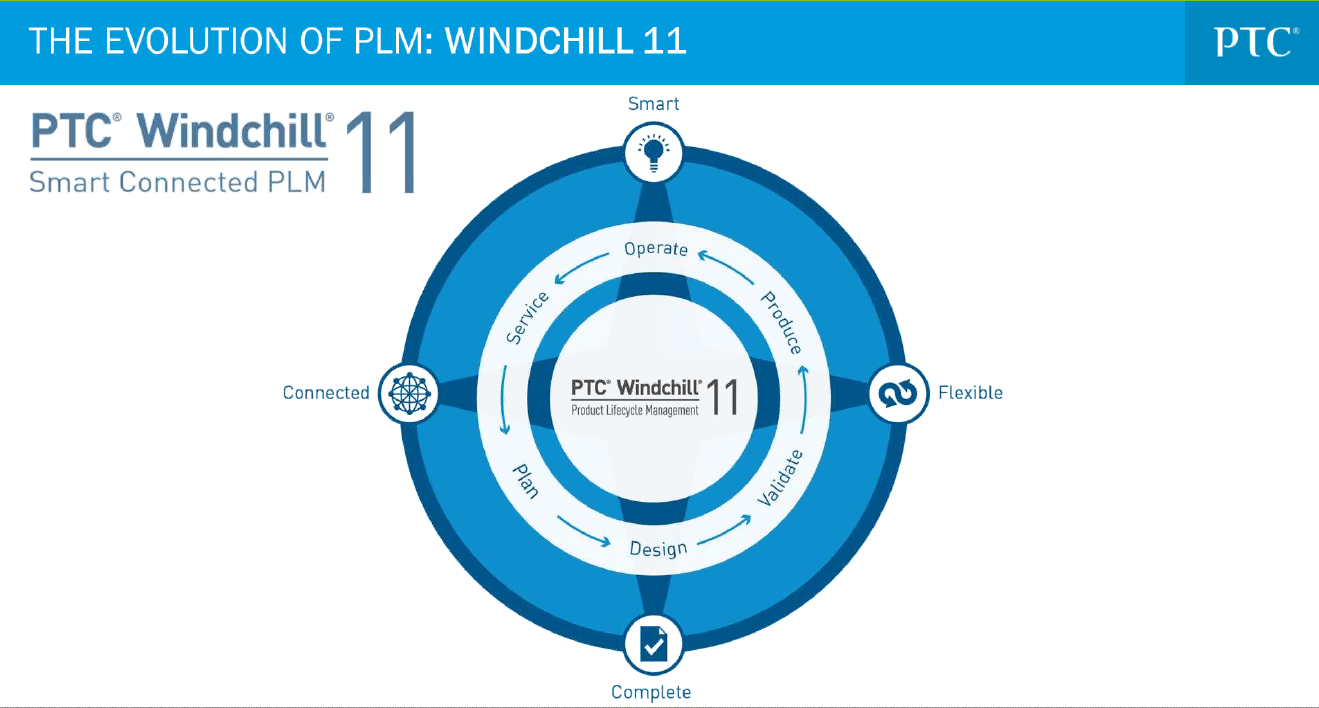PTC hopes its major PLM release Windchill 11 becomes a tool for a broader range of stakeholders in a project. The company describes it as the first smart, connected PLM.
The challenge of IoT and its attendant big data represents a transformational inflection point for design companies—for the first time companies enabling digital models are faced with incorporating real world data and managing that data. Likewise, their customers are being thrust into the world of big data, and the major CAD companies are scrambling to give customers useful tools before their competitors do or before interlopers take over from HPC (high performance computing).

PTC has been early into the IoT. The company has built a new division from its acquisition of ThingWorx in 2013, and it has built out a service business for support and maintenance. Now, with the latest version of their product lifecycle management (PLM) product, Windchill 11, PTC says they are offering the first “smart, connected” PLM.
As PTC rolled out their latest version of Windchill, they also provided a deeper look into the technology they’ve gained from ThingWorx and talked about how they are expanding the role of PLM beyond its traditional position behind the walls of the engineering department.
Kevin Wrenn, PTC’s GM of PLM says that with ThingWorx, PTC got technology that enables them to connect data from objects and from other information systems such as ERP, MES, etc. and to create mashups. In addition, the ability to gather relevant information is backwards compatible with earlier versions of Windchill so information can be gathered from versions back to 10.1.40 or later. For Windchill 11 PTC has created role based apps that can feed essential information to the people who need it, and nothing more. Wrenn said customers tell him that they’ve spent years inputting information into PLM systems, and the only people who use that information are the people who put the information into the system in the first place. The idea of this version is to give people a tool that’s easy enough to use and is relevant for users outside engineering and design processes.
Security has become an added benefit of the ability to create targeted information for users. Permissions can be set to enable only some parts of the design to be accessible as necessary.
New features in Windchill include Windchill Search, which features a unified search user interface that connects PTC’s PartsLink with core Windchill so that users search once and see the context of the results.

Integrated systems
PTC is bringing its Integrity ALM requirements management system into the loop as well. Windchill 11 has support for OSLC (Open Services for Lifecycle Collaboration) standards and when the latest version of Integrity is released in the Spring of 2016, the support for OSLC will enable updates between Integrity and Windchill to happen asynchronously. OSLC is an IBM backed standard for systems collaboration and PTC’s ALM (application lifecycle management) product Integrity plugs into that ecosystem.
What you’ll hear PTC say over and over again, is that Windchill provides a single source of the truth. As the company forges tighter links between its data products including Integrity, that single source of the truth is getting easier to access.
The new, more integrated Windchill can offer customers information about the lifetime of a part through Windchill Prediction (formerly Relex Reliability Prediction) and this goes back to those long suffering dedicated customers Kevin Wrenn has talked to who have been dutifully entering product information into the PLM system. All their work pays off as information on parts, inventory, purchasing, sourcing, etc. can be brought together with ThingWorx as it monitors operation and give customers reliable information and predictions such as meantime between failures (MTBF). Customers can opt in to Windchill Performance Advisor, which is powered by ThingWorx and they can get information for optimization, support, and service.
Finally, says PTC, Windchill is flexible because it can be made available to customers how they want and where they want. Windchill can be deployed in the cloud as an SAAS, via perpetual licensing and on-premise.
What do we think?
With this release of Windchill, PTC has been able to integrate more capabilities between PLM, design, service, and things. Proclaiming support for the Internet of Things is easy, but actually figuring out where all the pieces fit together is probably one of the biggest challenges in technology today – certainly for the design software companies which have lived so long outside the world of integrated systems. Until maybe 10 years ago, design software companies were defined by their silos. Today, they are enthusiastically breaking free and all the major companies are investing in IoT, big data, reality capture, etc. but PTC has depth thanks to its acquisitions and development. It’s also important to see that PTC is also building out connections with other providers including IBM.
Right now, it’s the enterprise-level companies who are taking the lead in IoT systems, but it’s the SMBs who are the bedrock of manufacturing and design. It’s going to take continuous work to push accessible tools out to the companies that need them the most.
And one of these days, it’s going to be time to come up with a better term than Product Lifecycle Management (PLM) because there’s so much more that everyone wants to do. —K.M.





